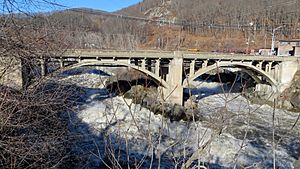Connecticut River facts for kids
Quick facts for kids Connecticut River |
|
|---|---|
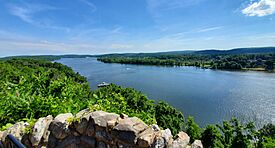
The Connecticut River seen from behind Gillette Castle in Lyme, Connecticut
|
|
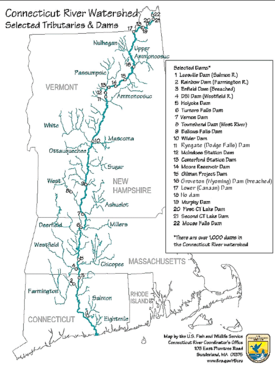
River map, with major tributaries and selected dams
|
|
| Native name | Kwenitegok (Abenaki) |
| Country | United States |
| Region | New England |
| State | Connecticut, Massachusetts, Vermont, New Hampshire |
| Cities | Springfield, Massachusetts, Hartford, Connecticut |
| Physical characteristics | |
| Main source | Fourth Connecticut Lake Coos County, New Hampshire, United States 2,660 ft (810 m) 45°14′53″N 71°12′51″W / 45.24806°N 71.21417°W |
| River mouth | Long Island Sound Old Saybrook and Old Lyme, Connecticut 41°16′20″N 72°20′03″W / 41.27222°N 72.33417°W |
| Length | 410 mi (660 km) |
| Discharge (location 2) |
|
| Basin features | |
| Basin size | 11,260 sq mi (29,200 km2) |
| Tributaries |
|
| Protection status | |
| Official name: Connecticut River Estuary and Tidal River Wetlands Complex | |
| Designated: | October 14, 1994 |
| Reference #: | 710 |
The Connecticut River is a very important river in the New England part of the United States. It's the longest river in the region, flowing about 406 miles (653 km) south through four states: New Hampshire, Vermont, Massachusetts, and Connecticut. The river starts near the border with Quebec, Canada, and ends in Long Island Sound between Old Saybrook and Old Lyme, Connecticut.
The area drained by the Connecticut River, called its watershed, is huge, covering 11,260 square miles (29,160 km²). This watershed includes parts of five U.S. states and even a bit of Canada. Many smaller rivers and streams, called tributaries, flow into the Connecticut River. It provides 70% of the fresh water that flows into Long Island Sound.
The Connecticut River Valley is famous for its rich farmland. It's also home to a busy area called the Hartford–Springfield Knowledge Corridor, where about two million people live around the cities of Springfield, Massachusetts, and Hartford, Connecticut.
Contents
The Connecticut River: A Journey Through Time
The name "Connecticut" comes from Native American words like quinetucket and kwinitekw. These words mean "beside the long, tidal river." Europeans started using this name in the early 1600s. They also called it "The Great River" or "Fresh River." The Dutch, who were early explorers, called it the "Verse River." Early European explorers spelled the name in different ways, like "Cannitticutt."
Native American Life Along the River
Scientists have found proof that people lived in the Connecticut River Valley for at least 6,000 years. Many Native American tribes lived in the rich Connecticut River Valley before Dutch explorers arrived in 1614. Most of what we know about these tribes comes from English writings from the 1630s.
The Pequots were a powerful tribe in the southern part of the valley. Their land stretched from the river's mouth up to Middletown, Connecticut. They sometimes had conflicts with nearby farming tribes like the Western Niantics. They also had a tense relationship with their rivals, the Mohegans. The Mattabesset (Tunxis) tribe lived near the "Big Bend" of the river at Middletown. Their village was located between the Pequots to the south and the Mohegans to the north.
The Mohegans lived in the area where Hartford is today. They became very strong after joining with the European colonists during the Pequot War in 1637. The Mohegans and Pequots had similar cultures because they had once been one group before becoming rivals.
The Pocomtuc tribe were farmers who lived in villages along the river near Springfield, Massachusetts. Their village of Agawam later became Springfield. They were friendly with the Puritan explorers who settled there. The rich soil in this area, all the way up to New Hampshire and Vermont, helped many Pocomtuc and Nipmuc settlements grow. Sometimes, tribes from New York, like the Mohawk and Iroquois, would visit these villages.
The Pennacook tribe helped settle many early arguments between colonists and other Native American groups. Their land reached from the Massachusetts border up to the White Mountains. The Western Abenaki (Sokoki) tribe lived in the Green Mountains of Vermont. They sometimes moved to Quebec but often returned to Vermont.
Early European Settlers and New Towns
In 1614, a Dutch explorer named Adriaen Block was the first European to map the Connecticut River. He sailed up to Enfield Rapids. He called it the "Fresh River" and claimed the land for the Netherlands. In 1623, Dutch traders built a fort and trading post in what is now Hartford, Connecticut. They called it Fort Huys de Hoop, which means "Fort House of Hope."
Four groups of Puritans also settled in the rich Connecticut River Valley. They founded two important cities: Hartford (in 1635) and Springfield (in 1636). The first group came from Plymouth Colony in 1632 and started the village of Matianuck, which is now Windsor, Connecticut. Another group from the Massachusetts Bay Colony founded Wethersfield, Connecticut, in 1633. They wanted a place where they could worship freely.
In 1635, Reverend Thomas Hooker led settlers from Cambridge, Massachusetts, to the area near the Dutch fort. There, he founded a town called Newtowne. Later, Newtowne took over Matianuck (Windsor).
A fourth English settlement was started by William Pynchon in 1635. He wanted to find the best place for trade and farming. His scouts found the Pocomtuc village of Agawam, which was a great spot. It was where a trade route crossed the Connecticut River, and two other rivers, the Chicopee and Westfield, joined it. This spot, just north of Enfield Falls, was perfect for traders. The settlement was first called Agawam Plantation. In 1641, it became Springfield and joined the Massachusetts Bay Colony. Springfield was the westernmost settlement for Massachusetts for a long time.
Hartford and Springfield quickly grew into important towns. By 1654, the English settlements were so successful that the Dutch had to give up some of their claims. A treaty set a new border, and the Dutch kept their trading post at Fort Huys de Hoop until the British took over in 1664.
River Borders and Early Conflicts
The Connecticut River Valley was a valuable place because of its location, rich soil, and natural resources. This led to many arguments over borders for hundreds of years. One big dispute started when Springfield left the Connecticut Colony in 1641 and joined the Massachusetts Bay Colony.
Hartford had a fort at the river's mouth in Old Saybrook to protect against various tribes and the Dutch. After Springfield joined Massachusetts, the Connecticut settlements asked Springfield's ships to pay tolls to pass the river's mouth. Springfield refused to pay without having a say in the fort's rules. In response, Massachusetts put a toll on Connecticut ships entering Boston Harbor. Connecticut depended on trade with Boston, so it dropped its tax on Springfield. This event helped draw the first state border across the Connecticut River.
The Fort at Number 4 in Charlestown, New Hampshire, was the northernmost British settlement on the river until 1763. After the French and Indian War, more colonists settled north of Brattleboro, Vermont. The population in the Upper Connecticut River Valley grew quickly.
Vermont was claimed by both New Hampshire and New York. King George III decided in 1764 that the border should be the western bank of the Connecticut River. People in Vermont, like Ethan Allen and the Green Mountain Boys, resisted New York's control. This led to the independent Vermont Republic in 1777, which later became the 14th U.S. state in 1791. The border between Vermont and New Hampshire was finally settled in 1933.
The River in the 1800s: Trade and Industry
The Treaty of Paris (1783), which ended the American Revolutionary War, created a new international border. This border was set at the "northwesternmost headwaters of the Connecticut" between New Hampshire and Canada. This led to a small border dispute and the short-lived Indian Stream Republic from 1832 to 1835.
The wide, fertile Connecticut River Valley attracted many farmers and traders. During the Industrial Revolution, the river's many waterfalls provided power for mills and factories. Cities like Springfield and Hartford became centers for new ideas and businesses.
The Enfield Falls Canal opened in 1829 to help boats get around the shallow Enfield Falls. The locks built for this canal gave the town of Windsor Locks, Connecticut, its name. The Connecticut River Valley became a hub for new technology into the 20th century. Railroads also grew, connecting Springfield and Hartford. This made the river less important for trade. From the late 1800s until today, the river has mostly been used for wildlife and fun activities.
Log Drives and Big Floods
Starting around 1865, the river was used for huge logging drives. Logs were floated from Third Connecticut Lake down to sawmills near Enfield Falls. Workers would guide the logs through rapids and past bridges. These large log drives stopped after 1915 because boat owners complained about the dangers. A final big drive happened in 1918 to help with wood demand during World War I.
In March 1936, heavy snowfall, an early spring thaw, and lots of rain caused the Connecticut River to flood badly. Many bridges were destroyed, and people had to be rescued by boat. The dam at Vernon, Vermont, was covered by 19 feet (5.8 m) of water. In Northampton, Massachusetts, over 3,000 people had to leave their homes. They found shelter at Amherst College and the University of Massachusetts, Amherst.
Huge ice jams made the flooding even worse. When a jam broke at Hadley, Massachusetts, the water rushed over the dam at Holyoke. The village of South Hadley Falls was badly damaged. In Springfield, Massachusetts, 5 square miles (13 km²) of land and 18 miles (29 km) of streets were flooded. About 20,000 people lost their homes. The city lost power, and police worked to maintain order. Rescue teams used boats to save people trapped in buildings. The American Red Cross and other groups helped with aid and manpower. The flood caused a lot of damage and left many people without homes.
To help prevent future serious floods, the Connecticut River Flood Control Compact was created in 1953. This agreement is between the states of Connecticut, Massachusetts, New Hampshire, and Vermont.
Water Supply and Conservation
In the 1930s, the Quabbin Reservoir was built. This reservoir diverted water from the Swift River, which feeds into the Chicopee River, a tributary of the Connecticut. This caused a lawsuit from Connecticut, but it was not successful.
By 1969, the demand for drinking water in eastern Massachusetts was more than the existing supply. Diverting water from the Connecticut River was considered. However, in 1986, the Massachusetts Water Resources Authority started a big effort to save water. By 1989, water use was reduced to safe levels.
The River's Journey: From Source to Sea
The Connecticut River is the largest river system in New England. Its watershed covers parts of Connecticut, Massachusetts, New Hampshire, Vermont, a small part of Maine, and even Quebec, Canada.
Where the River Begins: New Hampshire and Vermont
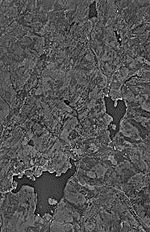
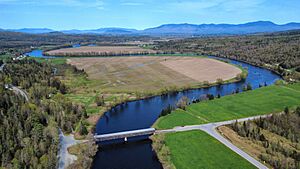
The Connecticut River starts in Fourth Connecticut Lake, a small pond in Pittsburg, New Hampshire. This is only about 300 yards (270 m) south of the Canadian border. It begins at an elevation of 2,670 feet (814 m) above sea level. The river flows through the other Connecticut Lakes and Lake Francis for 14 miles (23 km). Then, it forms 255 miles (410 km) of the border between New Hampshire and Vermont. As it flows south, the river drops more than 2,480 feet (756 m) in elevation.
The area around Lebanon, New Hampshire, and White River Junction, Vermont, is called the "Upper Valley." In 2001, the Trust for Public Land bought a large area of land in New Hampshire. This helped protect the land around the Connecticut Lakes Headwaters. A special agreement ensures that the land is managed sustainably and remains open to the public.
Through Massachusetts and Central Connecticut
After the last ice age, the Middle Connecticut River Valley was covered by a large lake called Lake Hitchcock. This is why the soil here is so rich and fertile. In this middle section, the river is deepest, reaching 130 feet (40 m) near the French King Bridge in Gill, Massachusetts. It is widest, at 2,100 feet (640 m), in Longmeadow. The river's largest waterfall, South Hadley Falls, has a drop of 58 feet (18 m).
This part of the river has beautiful green forests and farms. It's also known for its many college towns, like Northampton, South Hadley, and Amherst. Springfield is the most populated city on the river in this section. It sits where the Chicopee River and Westfield River join the Connecticut. This region is often called the Pioneer Valley. While the southern part of the valley in Massachusetts is quite urban, the northern part is mostly rural with famous Connecticut shade tobacco farms.
The Connecticut River is affected by the ocean's tides as far north as Enfield Rapids in Windsor Locks, Connecticut. This is about 58 miles (93 km) from the river's mouth. The busy Hartford-Springfield area, with two million residents, stretches between Amherst, Massachusetts, and Middletown, Connecticut. Hartford, the second-largest city on the river and the only state capital, is located on an old floodplain.
The River's End: Southern Connecticut and the Sound
About 15 miles (24 km) south of Hartford, near Middletown, the river narrows and then turns sharply southeast. In southern Connecticut, the river flows through a less populated, hilly, and wooded area. It then widens again and flows into Long Island Sound between Old Saybrook and Old Lyme. There are large, shifting sandbars at the river's mouth. Because of these sandbars, the Connecticut is one of the few major rivers in the Northeastern United States without a large port at its mouth. The main cities on the river, Hartford and Springfield, are 45 miles (72 km) and 69 miles (111 km) upstream, respectively.
Mouth and Tidelands
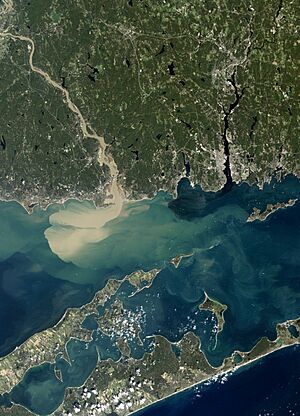
The Connecticut River carries a lot of silt, especially when snow melts in the spring. This creates a large sandbar near its mouth, making it hard for big ships to pass. This is why there isn't a major city right at the river's end.
The Nature Conservancy has called the Connecticut River's tidelands one of the Western Hemisphere's "40 Last Great Places." The Ramsar Convention on Wetlands also recognized its estuary and tidal wetlands as very important internationally. In 1997, the Connecticut River was named one of only 14 American Heritage Rivers. This recognized its special natural, economic, scenic, historic, and recreational qualities. In May 2012, the Connecticut River became America's first National Blueway, celebrating efforts to restore and protect it.
Dams Along the Way
The flow of the Connecticut River is slowed by many dams. These dams create a series of calm basins from Lake Francis Dam in New Hampshire down to the Holyoke Dam in Massachusetts. The Connecticut is one of the most dammed rivers in the United States. Scientists are working on ways to manage the water flow from the river's 54 largest dams. This helps balance human needs with the river's natural rhythm. The Cabot and Turners Falls hydroelectric stations produce up to 68 megawatts of electricity. The Holyoke Canal System and Hadley Falls Station at Holyoke Dam produce a combined 48 megawatts.
Many Streams Join the River
The Connecticut River watershed covers 11,260 square miles (29,160 km²). It includes 148 smaller streams and rivers, called tributaries, as well as many lakes and ponds. Some of the major tributaries (from north to south) are the Passumpsic, Ammonoosuc, White, Black, West, Ashuelot, Millers, Deerfield, Chicopee, Westfield, and Farmington rivers. The Swift River, which flows into the Chicopee, has been dammed to create the Quabbin Reservoir. This reservoir provides drinking water to the Massachusetts Water Resources Authority district, including Boston.
Wildlife and Nature: The River's Ecosystem
Along its southern parts, the Connecticut River has created a wide, fertile valley. This area, known as the Pioneer Valley in Massachusetts, has rich soils that are great for farming. Many types of trees grow along the riverbanks, including sycamores, cottonwood, willows, and dogwood.
The river and its many tributaries are home to many freshwater animals. These include dace, crawfish, hellgramites, freshwater mussels, frogs, snapping turtles, brook trout, sturgeon, catfish, and carp. Some fish, like rainbow trout, have been introduced to the river.
The river is also an important path for many anadromous fish. These fish, like American shad, lamprey, and Atlantic salmon, live in the ocean but swim upriver to lay their eggs. American eels are also present. Predators like striped bass also follow these migratory fish. Shad swim as far north as Holyoke, Massachusetts, where a fish elevator helps them get over the Holyoke Dam. They can pass another elevator in Turners Falls, Massachusetts, and reach at least Bellows Falls, Vermont. Harbor seals have been seen traveling upriver as far as Holyoke, chasing migratory fish. In the southernmost parts of Connecticut, near Long Island Sound, dolphins are sometimes spotted.
There are 12 types of freshwater mussels in the river. Most of them live in the main part of the Connecticut River. Eight of these 12 species are considered endangered or threatened in one or more states in the watershed.
Many colonial animal species live in the Connecticut River. Deeper areas are home to different colonial organisms, including bryozoa. Freshwater sponges, some as big as dinner plates, have been found by divers at depths of over 130 feet (40 m) near the French King Bridge in Erving, Massachusetts. Mussels, eels, and northern pike have also been seen there.
Fish of the Connecticut River
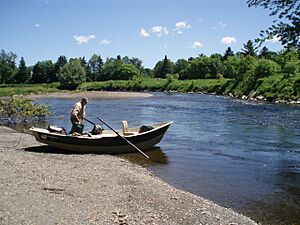
The river has several types of fish that migrate between fresh and salt water. These include brook trout, winter flounder, blueback herring, alewife, rainbow trout, large brown trout, American shad, hickory shad, smallmouth bass, Atlantic sturgeon, striped bass, American eel, and sea lamprey. There are also endangered shortnose sturgeon and dwarf wedgemussels. The United States Fish and Wildlife Service has worked to bring back Atlantic salmon to the river. These salmon had disappeared for over 200 years because of dams. Now, several fish ladders and fish elevators help fish swim upstream to their spawning grounds each spring.
Fish that live in the fresh and brackish water of the main river and its tributaries include common carp, white catfish, brown bullhead, fallfish, yellow perch, smallmouth bass, largemouth bass, northern pike, chain pickerel, bluegill, pumpkinseed sunfish, golden shiner, and rock bass.
The Connecticut Lakes, at the beginning of the river, have lake trout and landlocked salmon. Landlocked salmon swim into the river during spring and fall to spawn. Some parts of the river have special rules for fly-fishing only. Most of the river south of Lake Francis is open for lure and bait fishing. Two dams help keep the river water cold for miles downstream, making it great for summer fishing.
After the first major dam was built near Turners Falls, Massachusetts, 13 more dams stopped the big fish migrations. Efforts to restore salmon began in 1967. Fish ladders and an elevator at Hadley Falls have helped migrating fish return to some of their old spawning areas. From 1978 to 1992, warm water from the Vermont Yankee Nuclear Power Plant in Vernon, Vermont, was released into the river. This warm water reached 105°F (41°C) and affected the river for 55 miles (89 km) downstream. This thermal pollution seemed to cause an 80% drop in American shad numbers between 1992 and 2005. The nuclear plant closed at the end of 2014, and since then, the shad population has increased.
Fun and Future: Boating and Cleanup Efforts
Boating and Outdoor Fun
The part of the river near its mouth, up to Essex, is one of the busiest waterways in Connecticut. Local police and environmental officers patrol the area. Many towns have boats ready if needed. In Massachusetts, the most active part of the Connecticut River is around the Oxbow, near Northampton.
Camping is available along much of the river for people using non-motorized boats. This is part of the Connecticut River Paddlers' Trail, which has campsites along over 300 miles (480 km) of the river.
Cleaning Up the River
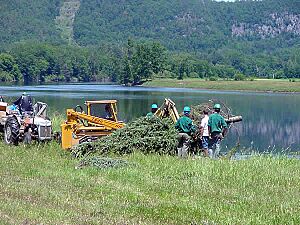
The Water Quality Act of 1965 made a big difference in controlling water pollution in the Connecticut River. Since then, the river has improved from Class D to Class B, meaning it's safe for fishing and swimming. Many towns along the Lower Connecticut River have limited new buildings along the banks. A website now provides water quality reports twice a week. These reports tell people if different parts of the river are safe for swimming, boating, and fishing.
Lists
Populated places
Tributaries
Listed from south to north by location of mouth:
- Black Hall River (Old Lyme, CT)
- Falls River (Essex, CT)
- Eightmile River (Hamburg, CT)
- Deep River (Deep River, CT)
- Salmon River (Moodus, CT)
- Mattabesset River (Middletown, CT)
- Hockanum River (East Hartford and Hartford, CT)
- Park River (Hartford, CT)
- Farmington River (Windsor, CT)
- Scantic River (South Windsor, CT)
- Westfield River (West Springfield and Springfield, MA)
- Mill River (Springfield, MA)
- Chicopee River (Chicopee and Springfield, MA)
- Manhan River (The Oxbow of Northampton, MA)
- Mill River (Northampton, MA)
- Fort River (Hadley, MA)
- Mill River (Hatfield, MA)
- Mill River (Amherst, MA)
- Sawmill River (Montague, MA)
- Deerfield River (Deerfield and Greenfield, MA)
- Fall River (Greenfield and Gill, MA)
- Millers River (Millers Falls, MA)
- Ashuelot River (Hinsdale, NH)
- Whetstone Brook (Brattleboro, VT)
- West River (Brattleboro, VT)
- Partridge Brook (Westmoreland, NH)
- Cold River (Walpole, NH)
- Saxtons River (Westminster, VT)
- Williams River (Rockingham, VT)
- Black River (Springfield, VT)
- Little Sugar River (Charlestown, NH)
- Sugar River (Claremont, NH)
- Blow-me-down Brook (Cornish, NH)
- Ottauquechee River (Hartland, VT)
- Mascoma River (West Lebanon, NH)
- White River (White River Junction, VT)
- Mink Brook (Hanover, NH)
- Ompompanoosuc River (Norwich, VT)
- Waits River (Bradford, VT)
- Oliverian Brook (Haverhill, NH)
- Wells River (Wells River, VT)
- Ammonoosuc River (Woodsville, NH)
- Stevens River (Barnet, VT)
- Passumpsic River (Barnet, VT)
- Johns River (Dalton, NH)
- Israel River (Lancaster, NH)
- Upper Ammonoosuc River (Northumberland, NH)
- Paul Stream (Brunswick, VT)
- Nulhegan River (Bloomfield, VT)
- Simms Stream (Columbia, NH)
- Mohawk River (Colebrook, NH)
- Halls Stream (Beecher Falls, VT)
- Indian Stream (Pittsburg, NH)
- Perry Stream (Pittsburg, NH)
Crossings
The Connecticut River can be a barrier for travel between western and eastern New England. Several major roads and train lines cross the river. These include Amtrak's Northeast Corridor, Interstate 95, Interstate 90 (Massachusetts Turnpike), Interstate 89, Interstate 93, and Interstate 84. Also, Interstate 91, which mostly follows the river, crosses it twice.
In literature
Lydia Sigourney wrote a poem called "Connecticut River" in 1834. She also wrote "Passage up the Connecticut" in 1845, which described a journey along the river.
Wallace Stevens, a famous American poet, lived in Hartford, Connecticut. He wrote many poems, including "The River of Rivers in Connecticut," during his daily walks.
Images for kids
-
View of the City of Hartford, Connecticut by William Havell
-
View from Mount Holyoke, Northampton, Massachusetts, after a Thunderstorm—The Oxbow (1836) by Thomas Cole
-
The Memorial Bridge across the Connecticut River at Springfield, Massachusetts, the river's largest city
-
The Oxbow, Connecticut River, at Northampton, Massachusetts c. 1910
-
Downtown Hartford, Connecticut, during the 1936 flood
-
Drift boat fishing guide working the river near Colebrook, New Hampshire
-
Looking north from the French King Bridge at the Erving-Gill town line in western Massachusetts
-
Mist upstream of the Bissell Bridge between Windsor and South Windsor, CT
-
View of Connecticut River downstream from Hartford as seen from East Hartford
-
Founders Bridge in Hartford, with a view of the Bulkeley Bridge upstream
See also
 In Spanish: Río Connecticut para niños
In Spanish: Río Connecticut para niños
- Equivalent Lands
- The Great Attack, the burning of American ships on the Connecticut River at Essex in 1814
- History of Connecticut
- Lake Connecticut, post-glacial predecessor to Lake Hitchcock
- Lake Hitchcock, post-glacial predecessor to the Connecticut River
- List of rivers of Connecticut
- List of rivers of Massachusetts
- List of rivers of New Hampshire
- List of rivers of Vermont


